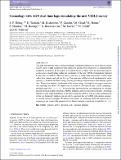Files in this item
Cosmology with AGN dust time lags -- Simulating the new VEILS survey
Item metadata
| dc.contributor.author | Hönig, S. F. | |
| dc.contributor.author | Watson, D. | |
| dc.contributor.author | Kishimoto, M. | |
| dc.contributor.author | Gandhi, P. | |
| dc.contributor.author | Goad, M. | |
| dc.contributor.author | Horne, K. | |
| dc.contributor.author | Shankar, F. | |
| dc.contributor.author | Banerji, M. | |
| dc.contributor.author | Boulderstone, B. | |
| dc.contributor.author | Jarvis, M. | |
| dc.contributor.author | Smith, M. | |
| dc.contributor.author | Sullivan, M. | |
| dc.date.accessioned | 2016-11-18T12:30:11Z | |
| dc.date.available | 2016-11-18T12:30:11Z | |
| dc.date.issued | 2017-01-11 | |
| dc.identifier | 247732225 | |
| dc.identifier | 821b7623-7d84-4c4d-94f0-6b0159893121 | |
| dc.identifier | 85014696125 | |
| dc.identifier | 000393647100031 | |
| dc.identifier.citation | Hönig , S F , Watson , D , Kishimoto , M , Gandhi , P , Goad , M , Horne , K , Shankar , F , Banerji , M , Boulderstone , B , Jarvis , M , Smith , M & Sullivan , M 2017 , ' Cosmology with AGN dust time lags -- Simulating the new VEILS survey ' , Monthly Notices of the Royal Astronomical Society , vol. 464 , no. 2 , pp. 1693-1703 . https://doi.org/10.1093/mnras/stw2484 | en |
| dc.identifier.issn | 0035-8711 | |
| dc.identifier.other | ArXiv: http://arxiv.org/abs/1609.09091v1 | |
| dc.identifier.uri | https://hdl.handle.net/10023/9843 | |
| dc.description.abstract | The time lag between optical and near-infrared continuum emission in active galactic nuclei (AGN) shows a tight correlation with luminosity and has been proposed as a standardizable candle for cosmology. In this paper, we explore the use of these AGN hot-dust time lags for cosmological model fitting under the constraints of the new VISTA Extragalactic Infrared Legacy Survey (VEILS). This new survey will target a 9 deg2 field observed in J and Ks band with a 14-d cadence and will run for 3 yr. The same area will be covered simultaneously in the optical griz bands by the Dark Energy Survey, providing complementary time-domain optical data. We perform realistic simulations of the survey setup, showing that we expect to recover dust time lags for about 450 objects out of a total of 1350 optical type 1 AGN, spanning a redshift range of 0.1 < z < 1.2. We use the lags recovered from our simulations to calculate precise distance moduli, establish a Hubble diagram, and fit cosmological models. Assuming realistic scatter in the distribution of the dust around the AGN as well as in the normalization of the lag–luminosity relation, we are able to constrain ΩΛ in ΛCDM with similar accuracy as current supernova samples. We discuss the benefits of combining AGN and supernovae for cosmology and connect the present work to future attempts to reach out to redshifts of z > 4. | |
| dc.format.extent | 1998104 | |
| dc.language.iso | eng | |
| dc.relation.ispartof | Monthly Notices of the Royal Astronomical Society | en |
| dc.subject | Galaxies: active | en |
| dc.subject | Distance scale | en |
| dc.subject | Infrared: galaxies | en |
| dc.subject | QB Astronomy | en |
| dc.subject | QC Physics | en |
| dc.subject | NDAS | en |
| dc.subject.lcc | QB | en |
| dc.subject.lcc | QC | en |
| dc.title | Cosmology with AGN dust time lags -- Simulating the new VEILS survey | en |
| dc.type | Journal article | en |
| dc.contributor.sponsor | Science & Technology Facilities Council | en |
| dc.contributor.institution | University of St Andrews. School of Physics and Astronomy | en |
| dc.identifier.doi | https://doi.org/10.1093/mnras/stw2484 | |
| dc.description.status | Peer reviewed | en |
| dc.identifier.grantnumber | ST/M001296/1 | en |
This item appears in the following Collection(s)
Items in the St Andrews Research Repository are protected by copyright, with all rights reserved, unless otherwise indicated.

